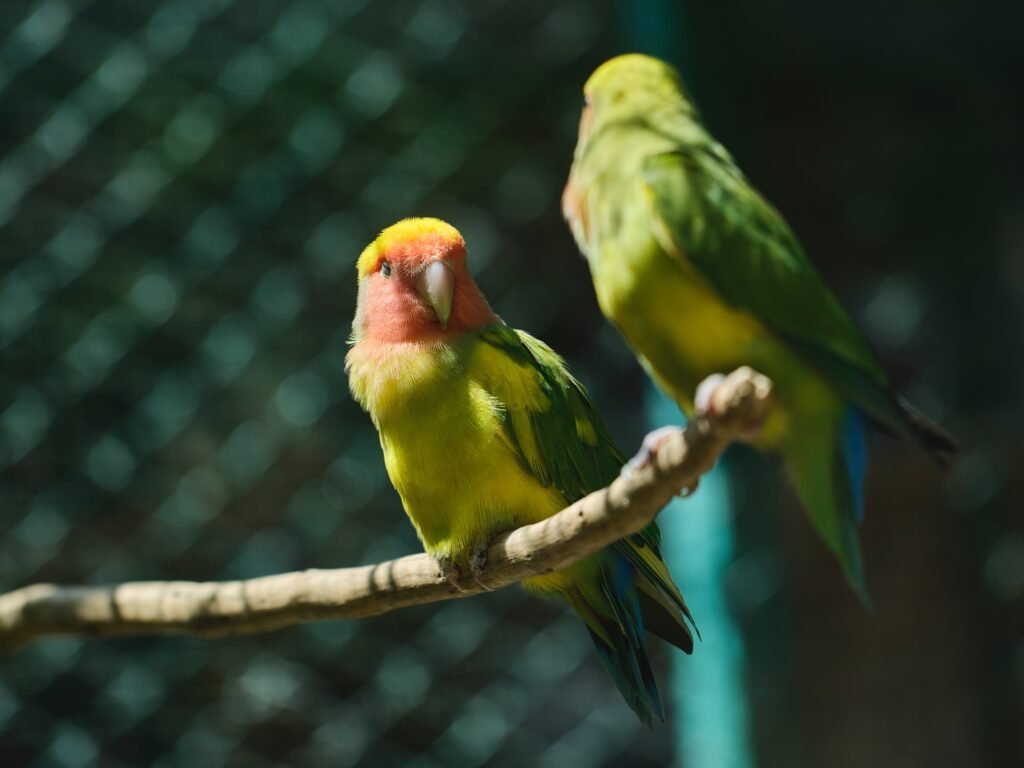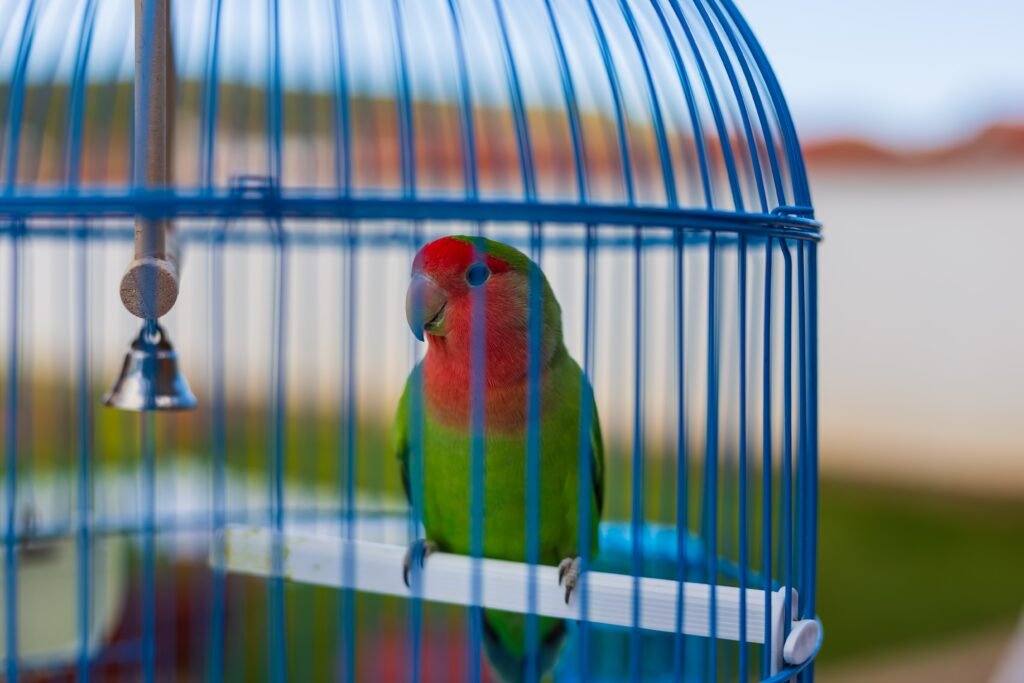Lovebirds are beautiful and fascinating creatures known for their strong bond and affectionate nature toward their partners. If you are a lovebird owner or someone interested in these charming birds, it is essential to understand the importance of building and maintaining a harmonious lovebird relationship. This article will explore various aspects of lovebird pair bonding, including tips on selecting compatible partners, fostering a strong bond, and ensuring a happy and healthy relationship.
Selecting Compatible Partners
Choosing the right lovebird pair is crucial for establishing a successful and harmonious relationship. Here are some factors to consider when selecting compatible partners for your lovebirds:
- Age and Gender: Lovebirds are monogamous birds, and it is recommended to pair birds of the same species and age to ensure compatibility. This is because birds of similar age will have similar energy levels and behavioural patterns, making it easier for them to understand and relate to each other. Additionally, determining the genders of the birds can prevent unnecessary conflicts or aggression within the pair.
- Observation and Compatibility: Before pairing lovebirds, observing their behaviour towards each other is advisable. Look for signs of mutual grooming, preening, or sharing food, as these are indicators of potential compatibility. If the birds show positive interactions and seem comfortable in each other’s presence, it is more likely that they will form a strong bond.
- Socialization: If possible, gradually introduce the lovebirds to neutral territory to gauge their reaction to each other. This can be done by placing their cages side by side for a few days, allowing them to observe and interact without direct contact. It is essential to ensure that both birds are comfortable and show signs of interest in one another. If they display aggression or fear, it may be necessary to consider other potential partners.
Fostering a Strong Bond
Once you have selected compatible lovebird partners, fostering a strong bond between them is crucial. Here are some tips to help you in this process:
- Housing: Provide a spacious and comfortable cage or aviary for your lovebirds. It should be large enough for them to fly and move around freely, as lovebirds are active birds that require plenty of exercise. Having adequate perches, toys, and nesting boxes can contribute to their well-being. Consider adding different types of perches at varying heights to encourage natural movement and exercise.
- Regular Interaction: Spend quality time with your lovebirds daily. Talk to them softly, offer treats, and engage in gentle handling. This interaction will help build trust and strengthen your bond with the birds. Lovebirds enjoy human companionship and will thrive when given attention and affection. Regular interaction also allows you to monitor their behaviour and health closely.
- Feeding Together: Encourage your lovebirds to eat together. Sharing meals promotes a sense of togetherness and mimics their natural behaviour in the wild. Offer a balanced and nutritious diet that includes a variety of fresh fruits, vegetables, seeds, and pellets. Ensure the food is placed in separate dishes to prevent aggression during feeding.
- Mutual Grooming: Lovebirds engage in mutual preening to strengthen their bond. To encourage this behaviour, provide them with suitable grooming materials, such as soft bristle brushes or bird-safe branches. Grooming each other helps in bonding, removes dirt and parasites from their feathers, and promotes a sense of security and well-being.
- Playtime and Enrichment: Offer a variety of toys, swings, and puzzles to keep your lovebirds mentally stimulated and entertained. Playtime is fun for the birds and strengthens their bond as they engage in activities together. Rotate the toys regularly to prevent boredom and provide new challenges for the birds. Additionally, consider providing natural perches, such as branches with bark, to stimulate their instincts.
Ensuring a Happy and Healthy Relationship
Maintaining a happy and healthy relationship between lovebirds requires ongoing care and attention. Here are some tips to ensure the well-being of your lovebird pair:
- Regular Vet Check-ups: Schedule regular visits to an avian veterinarian for routine health check-ups. Lovebirds are prone to certain health issues, such as respiratory problems and feather plucking, so monitoring their health and seeking professional advice when needed is essential. Regular check-ups can help detect any underlying health issues and ensure timely treatment if required.
- Safe Environment: Keep the lovebird’s environment clean, well-ventilated, and free from any potential hazards. Avoid exposing them to harmful substances like tobacco smoke, toxic fumes, or loud noises that may cause stress or harm. Provide a comfortable temperature range and ensure adequate lighting for their well-being. Regularly clean their cage, perches, and toys to maintain hygiene.
- Exercise and Flight: Lovebirds are active birds and require regular exercise to maintain their physical and mental well-being. Allow them supervised flight time outside the cage in a safe, enclosed space. This can be achieved by setting up a designated bird-proofed area or using a harness for outdoor adventures. Flight stimulates their muscles and provides mental stimulation, reducing the risk of obesity and boredom.
- Establish a Routine: Lovebirds thrive on routine and predictability. Establish a consistent daily routine for feeding, playtime, and sleep to give your birds a sense of security and stability. Consistency in their daily activities helps reduce stress and anxiety, making them feel more comfortable and content. Make sure to provide a quiet and undisturbed sleeping area to ensure restful sleep.
- Avoid Isolation: Lovebirds are highly social birds and require companionship. They form strong bonds not only with their human caregivers but also with their kind. If you cannot spend sufficient time with them, consider providing them with a companion bird or considering their placement in a household where they can receive the necessary attention and interaction. A lack of social interaction can lead to loneliness and behavioural issues in lovebirds.
Building and maintaining a harmonious lovebird relationship takes time, patience, and effort. Following these guidelines and providing the necessary care and attention can create a loving and fulfilling bond with your lovebird pair. Enjoy the journey of witnessing their affectionate behaviours and the joy they bring to your life.
FAQ
- What factors should I consider when selecting compatible lovebird partners?
- Age and Gender: Birds of the same species and age are recommended for compatibility.
- Observation and Compatibility: Look for signs of mutual grooming, preening, or sharing food.
- Socialization: Introduce the lovebirds gradually in a neutral territory to gauge their reaction.
- How can I foster a strong bond between my lovebird pair?
- Provide spacious and comfortable housing with perches, toys, and nesting boxes.
- Spend quality time with them daily, talk to them softly, offer treats, and engage in gentle handling.
- Encourage them to eat together and offer a balanced and nutritious diet.
- Provide suitable grooming materials and encourage mutual preening.
- Offer a variety of toys, swings, and puzzles for mental stimulation and playtime.
- How can I ensure a happy and healthy relationship between my lovebirds?
- Schedule regular visits to an avian veterinarian for routine health check-ups.
- Keep their environment clean, well-ventilated, and free from potential hazards.
- Allow them supervised flight time outside the cage in a safe, enclosed space.
- Establish a consistent daily routine for feeding, playtime, and sleep.
- Provide companionship and avoid isolation by considering a companion bird or suitable placement.
- What are some important tips for maintaining the well-being of my lovebird pair?
- Monitor their health with regular vet check-ups and seek professional advice when needed.
- Keep their environment clean, well-ventilated, and free from potential hazards.
- Provide regular exercise and flight opportunities to maintain their physical and mental well-being.
- Establish a consistent daily routine for feeding, playtime, and sleep.
- Provide companionship and avoid isolation to prevent loneliness and behavioural issues.


